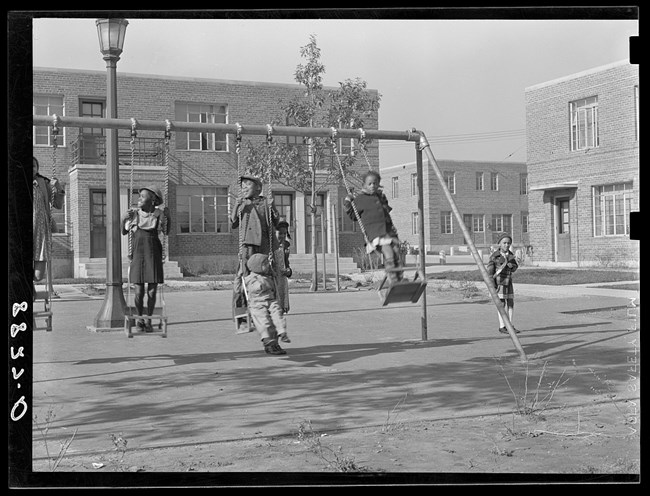Omaha is a diverse city of many ethnicities, languages, customs, and cultures. To help you learn more about the city's many cultures, this page is divided into a historical overview, followed by a listing of historic properties that represent the city's diversity.

Vachon, John, photographer. PWA Public Works Administration housing projects. Omaha, Nebraska. United States Nebraska Omaha Douglas County, 1938. Nov. Photograph. https://www.loc.gov/item/2017762718/.
Overview
From its founding in 1854, Omaha was a desirable location full of economic opportunities which enticed a diverse group of people to the city. In the late nineteenth century, Omaha’s population grew exponentially with the arrival of a large group of laborers, eager to find work in the new railroad and meatpacking industries. Omaha doubled in size between 1870 and 1880 and quadrupled in the following decade. Throughout the nineteenth and twentieth centuries, immigrants from all across the globe called Omaha their home. They fused old customs with new opportunities to create a multicultural city visible not only in the enclaves and neighborhoods they lived in, but also the lasting institutions they created.From 1860 on, the Union Pacific Railroad’s high demand for manpower attracted many immigrants to Omaha. Once in Omaha, cultural groups tended to stick together, holding on to familiarity in new places. The result of this was the creation of enclaves and neighborhoods in which these ethnic groups lived.
Czech immigrants came to Omaha shortly after the Civil War and lived in an area near downtown. Many also settled in South Omaha and worked for the packing houses. Little Bohemia was the center of social and cultural activities for the Czech enclave in Omaha, centered around the Prague Hotel, which was owned and operated by a Czech immigrant.
Italian immigrant Vincenzo Pietro Chiodo constructed four apartments between 1909 and 1918: The Leone, Florentine, and Carpathia Apartments, and the Chiodo Apartments. Chiodo was a leader in the Italian social and religious communities and owned much real estate in the Italian enclave southeast of downtown, called Little Italy. Like Czech and Italian immigrants, Irish newcomers also created tangible cultural institutions to represent their heritage. Holy Family Church, constructed in 1883, served the Irish immigrants who worked for the railroad. Irish immigrants greatly strengthened the Roman Catholic Church as the first three bishops in Omaha were natives of Ireland.
Diversity in the city is perhaps most visible in South Omaha, where Eastern European immigrants were gradually joined by Mexican immigrants in the stockyards and packing houses in the early twentieth century. The Polish Home served as a cultural gathering place for Omaha’s Polish American community and now is El Museo Latino, highlighting South Omaha’s growing Latino population.
The African American community had and continues to have a strong presence in Omaha. During the Great Migration many African Americans from rural southern areas to cities in the North and Midwest, doubling the number of African Americans in Omaha to over than 10,000 between 1910 and 1920. They primarily settled near the North 24th and Lake Streets Historic District. Within the district, multiple individual properties highlight Omaha’s rich African American history, including the Jewell Building and the Omaha Star. The Omaha Star newspaper was instrumental in Omaha’s Civil Rights movement, as was the Hope Lutheran Church, which along with other Black churches in North Omaha, had pastors active in the fight for equality and routinely held meetings. The Malcolm X House Site pays tribute to the civil rights activist who was born in Omaha. Individually and collectively, these properties embody the history of Omaha’s Black community.
Omaha’s Jewish community is best represented by Wohlner’s Neighborhood Grocery served as a commercial institution for the Jewish community. Albert Wohlner, a Jewish immigrant from Russia and prominent figure in the Omaha grocery industry, opened the store in 1940. The family tradition remains a staple of the community today and the current Wohlner’s Grocery is run by Wohlner’s descendants.
Omaha’s Chinese population likely arrived in Omaha from California shortly after the completion of the transcontinental railroad in 1869. The Chinese population of Omaha grew throughout the last quarter of the nineteenth century, with estimates that “several hundred” Chinese lived in Omaha’s Chinatown by the early twentieth century, a four-block area near 12th and Douglas Streets. Many Chinese American businessmen and tradesmen organized themselves into tongs, often viewed as Chinese chamber of commerce, a mutual aid society that helped members in need, and a social center Omaha’s Chinese population for much of the early 20th century. Omaha’s On Leong Tong House is one of the last extant resources that highlight Omaha’s Chinese American community.
While noticed more for its architecture than its use the Danish Brotherhood in America Headquarters Building is an early postmodern office building with Danish architectural details. Located within the Gold Coast Historic District, the building was constructed for a Danish-American benevolent society and insurance company.
You can find the historic properties under this Story – along with others throughout Omaha – by visiting the Travel Omaha, NE Map.
Historic Properties Related to Omaha's Diversity
Explore Omaha's Historic Stories
Last updated: April 5, 2023
